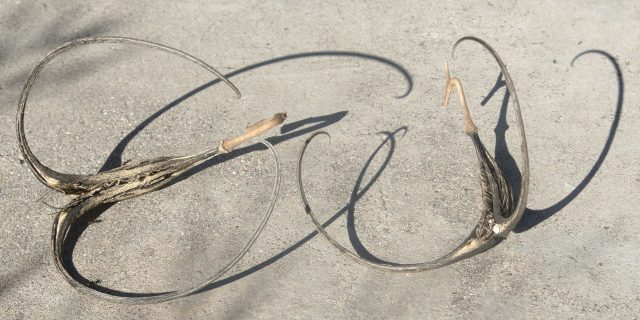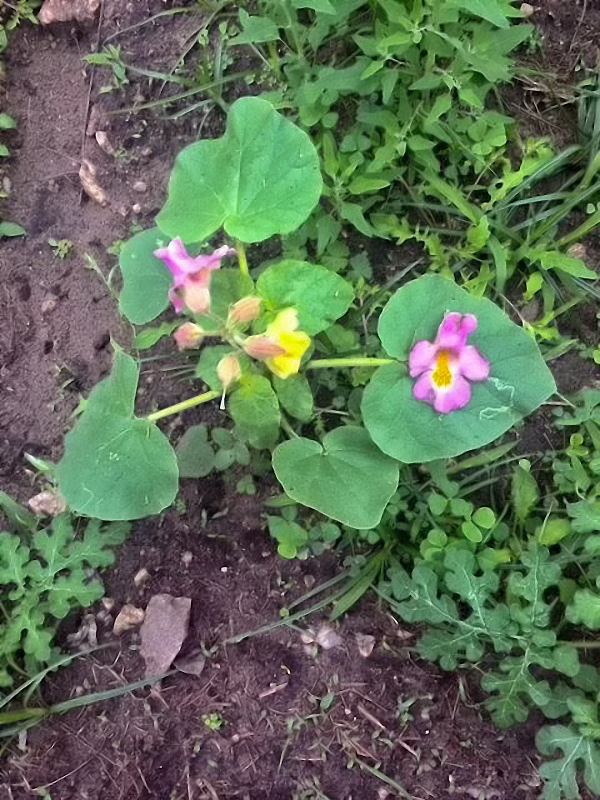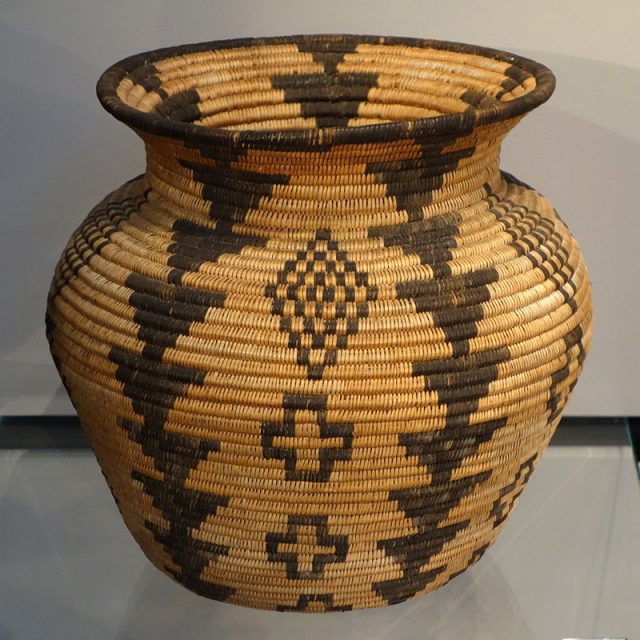03/03/017 – Devil’s Claw— A Wildflower with Wicked Way
Last week Jimmy Jackson sent me a photo of a strange wildflower. It looked like a snapdragon that had escaped a flowerbed. However, looking at the heart-shaped leaves, I realized that it could not be a snapdragon. It was definitely a wildflower and one that I did not know.
Or maybe I did know it. A word popped into my head: Martin. What? What does the word “martin” have to do with this pink and yellow flower?
Never one to waste a hunch, I went to the index of my wildflower field guide. No “martin” was listed but Martyniaceae was. I checked out the entry on page 421.

These two pods of Devil’s Claw cast eerie shadows but you can see how the long incurved beaks might wrap around the hoof a large grazing animal. Wikimedia Commons Photo.
It read: “DEVIL’S CLAW FAMILY (Martyniaceae). Sticky-haired plant. Large, showy 2-lipped flowers. Stamens 4. Very large, 2-hooked, clawlike seed capsule. Yellow, p. 122. Red, p. 316.”
Now I remembered identifying this plant. Years ago, I found a bush with double-clawed seedpods at the edge of a plowed field. That time I saw only the ripe seedpods, no flowers remained on the plant. But, the seedpods were so distinctive I was able to figure out what it was. And I saw the photos for the flowers. Some deep recess of my brain must have stored that information.
The pictures I saw were of pale pink to white flowers with purple spots on the throat. There was also a bee-guide in the form of a yellow streak leading into the throat of the flower. Although a brighter pink, the flower Jimmy had was like the photos. We had Devil’s Claw on our hands.

This looks like a cultivated garden flower but it is not. The blooms are loosely attached to the flower spike (here the top blossom fell off and is resting on the leaf). At this stage, the plant gives no indication as to why it is called Devil’s Claw. Jimmy Jackson Photo.
There are several species of Devil’s Claw: a yellow-flowered perennial form found mostly west of here; and the reddish-pink, lavender, and purple forms. All produce those wicked-looking, long-clawed seedpods. The pods are about two inches long with three to four inch long, incurved beaks. The incurved “claws” fit nicely over the hoof of a large grazing animal. It anchors itself almost like a shoe to the foot of the beast. The pod gets shaken and broken apart by the movement of the animal, dispersing the seeds over a wide area. Eventually the empty pod and its claws lose their grip and drop off.
As wicked as the claws look, they are springy and flexible. They do little damage to an animal’s foot. The pod’s design is ingenious for spreading the plant all over the southwest, however. Indigenous peoples of the southwestern United States and Mexico made good use of Devil’s Claw. The pods and seeds are both edible and nutritious. Native tribes and settlers would gather the green pods in early summer and cook them like okra. The unripe pods reportedly were good pickled as well. Even when the pod has become woody, the seeds inside are tender and delicious. Mexicanos eat the seeds fresh from the fields, or roasted, and sometimes ground into a meal. Interestingly, for a time in the early 1900s, Devil’s Claw was grown in Michigan and Massachusetts, and the pods canned commercially!

This basket is a classic example of indigenous peoples’ use of native plants. The basket is made of split willow twigs and the slender black claws of Devil’s Claw pods. Wikimedia Commons Photo.
Unripe pods of Devil’s Claw have a single horn at the end. This has given the plant the alternate name of Unicorn Plant. When the seedpod dries to a woody hull, this horn splits into two black claws. Native peoples would collect these and use the slender claws in basket-weaving. Devil’s claw fibers add strength to split willow twigs and a nice black color for patterns in the baskets. The Papagos tribe harvested the longest claws they could find, and saved the seeds from those plants. By selective breeding, they produced a long-clawed Devil’s Claw variety. It has claws over eight inches long!
If you are crafty and creative, you can think of other uses for the Devil’s Claw seedpods. Indigenous people did. Painted and affixed with legs, the pods become whimsical birds and dragons. Made into figurines, the “wicked” Devil’s Claws become toys for children and cats.
I hope you run across a Devil’s Claw when you go wildflowering. Save the seeds and start growing some of these unusual plants. Try your hand at the ancient craft of basket-weaving. Make odd bird figurines. Or sample pickled pods.
Whether you grow this plant for its pretty flowers, for a foodstuff, for fibers, or for the sheer fun of growing an oddity, you won’t go wrong with Devil’s Claw. Remember, it only looks wicked!
If you would like to offer comments, please click through to the discussion page
